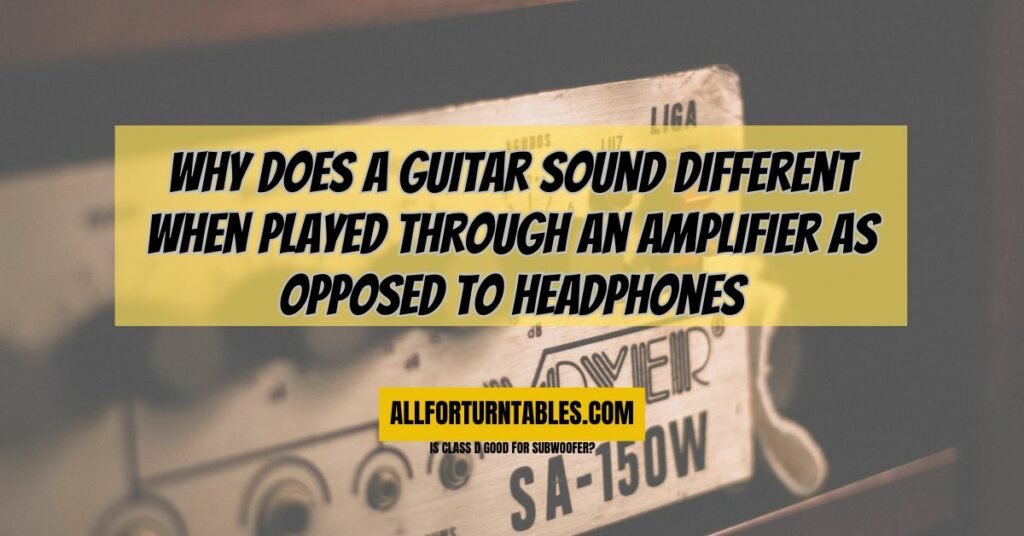When it comes to playing the guitar, the choice of amplification can significantly impact the sound you produce. Whether you’re a seasoned guitarist or just starting your musical journey, you may have noticed that the guitar sounds different when played through an amplifier compared to when you plug in your headphones. In this comprehensive article, we’ll unravel the reasons behind this phenomenon and explore the factors that contribute to the unique sonic characteristics when a guitar is played through an amplifier and headphones. Let’s dive into the world of guitar amplification and discover why it alters the guitar’s sound.
Understanding the Basics
Before we delve into the nuances of amplification, let’s establish a foundational understanding of the key elements at play:
- Guitar: The guitar is a stringed musical instrument that produces sound through the vibration of its strings. Electric guitars have pickups that capture these vibrations and convert them into electrical signals.
- Amplifier: A guitar amplifier is an electronic device designed to take the weak electrical signals from the guitar’s pickups and boost them to a level that can drive a speaker, creating audible sound.
- Headphones: Headphones are personal audio devices that convert electrical signals into sound, delivering it directly to your ears. They provide a private listening experience.
Why Guitars Sound Different Through Amplifiers and Headphones
- Speaker vs. Headphone Drivers:
- Amplifier: When you play your guitar through an amplifier, the amplified signal is sent to a speaker, which produces sound by moving air. The speaker’s size, design, and materials significantly influence the resulting tone. Guitar amplifiers are often equipped with specialized speakers designed to color the sound in specific ways, contributing to the unique character of guitar amplification.
- Headphones: When you use headphones, you bypass the speaker entirely. Instead, the electrical signal is sent directly to the headphone drivers, which are much smaller and designed for close-range listening. This difference in size and function can lead to a more detailed and immediate representation of the guitar’s sound without the influence of a speaker.
- Tonal Shaping and Effects:
- Amplifier: Guitar amplifiers often include built-in tone controls, equalization options, and onboard effects like distortion, reverb, and modulation. These features allow you to shape the guitar’s sound and create various sonic textures, giving the amplifier its distinctive character.
- Headphones: When you plug your guitar directly into headphones, you bypass the amplifier’s tone-shaping and effects. This results in a cleaner and more unprocessed representation of the guitar’s natural sound.
- Sound Projection:
- Amplifier: Amplifiers are designed to project sound into a room, creating an acoustic experience where the sound interacts with the environment. The room’s acoustics, size, and shape can further influence the perceived sound.
- Headphones: Headphones provide a direct sound path to your ears, eliminating external factors such as room acoustics. This results in a more controlled and intimate listening experience.
- Volume and Feedback:
- Amplifier: Amplifiers can produce significant volume levels, which can lead to feedback and resonance effects when the guitar is played at high volumes. This feedback can become an integral part of a guitarist’s expression.
- Headphones: Headphones offer precise volume control and isolation, reducing the likelihood of feedback and allowing for quieter and more controlled practice sessions.
In conclusion, the differences in how a guitar sounds when played through an amplifier versus headphones are the result of several key factors, including the influence of speaker drivers, tonal shaping, sound projection, and volume control.
Both amplifiers and headphones offer unique listening experiences, and as a guitarist or enthusiast, you have the opportunity to explore and appreciate the sonic nuances of each. Whether you’re aiming for the raw, unadulterated sound of headphones or the dynamic, effects-laden experience of an amplifier, these differences contribute to the rich tapestry of guitar music and its endless potential for creative expression. Embrace both worlds, and let your guitar journey be a captivating exploration of sound.


